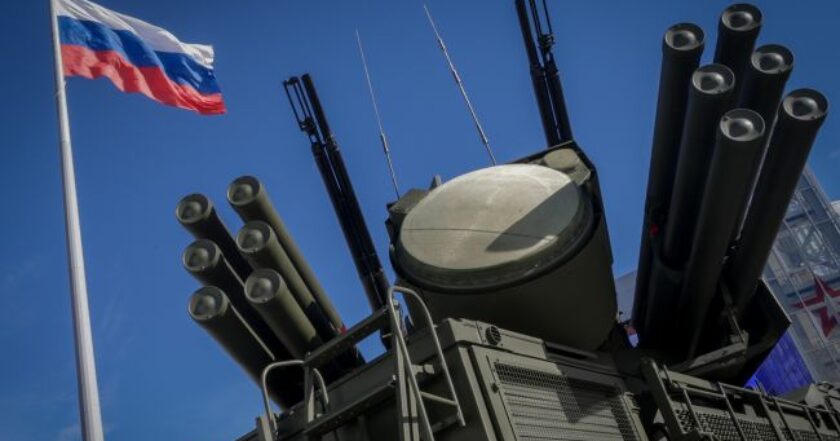Russia's air defense in Leningrad region focused on defending against NATO, not southern threats – ISW

Photo: Getty Images
On January 21, a Russian insider source said that the air defense of the Russian Federation does not cover the Leningrad region well.
The Institute for the Study of War (ISW) reported this.
Military analysts, citing a source, report that Russian air defenses in the Leningrad region are probably not ready to defend against strikes from the south.
Russian air defense systems in the Leningrad region are most likely positioned to defend against strikes from the northwest and west, as Russia has historically built its air defenses in the area to defend against hypothetical NATO attacks.
The Russian military is currently reforming the Leningrad Military District (LMD) with the intention of preparing for a potential war against NATO and possibly deploying military assets along the border with NATO members.
Ukrainian strikes in the Leningrad region could force Russian forces to redeploy short-range air defense systems along the expected flight paths of Ukrainian drones to protect potential strategic targets.
ISW believes that Russian forces using short-range air defense systems, such as Pantsir, may not be able to engage all important potential targets in the Leningrad region without bringing additional systems to the area, and continued Ukrainian strikes deep in Russia's rear can increase the pressure on Russian air defense as a whole.
For reference:
Sources of RBC-Ukraine reported that Russia was forced to transfer its anti-aircraft defense from the front after the attack on the Ust-Luga Oil gas terminal in the Leningrad Region.
The oil terminal Ust-Luga Oil is one of the newest and most important in the Russian Federation. It works for export, but it also supplies fuel for Russian troops.
After the Security Service of Ukraine's attack, all the tankers that were near the terminal went far out to sea. Their download failed. The attack of Ukrainian drones suspended the work of the plant.
It is noted that the work of the Novatek company's oil refining complex in the port of Ust-Luga will probably resume within weeks or even months.
One of the Russian investment banks estimated that an attack on the company's facilities could affect a quarter of its revenues.
The fire at the marine terminal, where the company's factories were located, was extinguished more than a day after the fire, reports the Russian propaganda agency TASS.
"This Ukraine's Security Service attack caused not only significant material but also image damage to the Russian Federation. The vaunted Russian anti-aircraft defense demonstrated its leakiness," the source said.
According to the source, the Russians are forced to transfer even more air defense systems from the front to protect the rear.
What is known about the attack on January 21
Officially, the Ministry of Defense of Russia announced at night the alleged downing of drones over the territory of Tula, Oryol, and Smolensk regions (the latter was attacked twice).
However, the fire in the port of the Leningrad region was not mentioned at all.
Residents heard the sounds of drones, after which explosions rang out near the terminal of the sea trade port in the village of Ust-Luga, located on the shore of the Gulf of Finland of the Baltic Sea.
A fire broke out there. Russian mass media reported that either the port's oil or coal terminal was on fire.
Later, the governor of the Leningrad Region, Oleksandr Drozdenko, reported that the fire occurred at the Novatek company terminal. According to him, there were no casualties; the personnel was evacuated.
"The Kingisep district in the Leningrad region has declared a state of heightened alertness following a fire at the Novatek terminal," he added.
In addition, there was an attack by Ukrainian drones on the Shcheglovsky Val defense enterprise in the city of Tula in the Russian Federation.
It is worth adding that the company that was attacked by Ukrainian drones produces, in particular, Pantsir-S anti-aircraft missile systems.
Earlier, Rubryka reported that the Russian Ministry of Defense announced the downing of drones over Tula.
However, the mass media and residents reported a powerful explosion and fire in the Proletarsky district of the city, where the Shcheglovsky Val plant is located.
In addition, on the night of January 21, Ukrainian drones in the Smolensk region attacked a Russian aircraft factory, where aircraft and other military equipment are manufactured and repaired.
According to a media interlocutor, hits were recorded near Smolensk.
It is worth noting that the Smolensk Aviation Plant produces Kh-59 cruise missiles of various modifications, which are used by Russian forces to attack military and civilian targets in Ukraine.
In addition, the company is under the sanctions of the European Union and the United States.
It should be noted that the plant was already attacked by drones in October and November 2023.
So, on October 1, drones attacked the cities of Smolensk and Sochi in the Russian Federation. Then, the governor of the Smolensk region said that the drones were trying to hit the aircraft factory in Smolensk.
On November 27, the Ministry of Defense's main intelligence directorate attacked the Smolensk Aviation Plant in Russia with drones. The operation was successful; the targets were hit.
Next, the Russians announced the "destruction of all drones." However, they mentioned that one of the UAVs still landed on the roof of a workshop at the factory and exploded. As a result, both the roof and ceiling beams were damaged.






















































